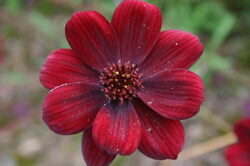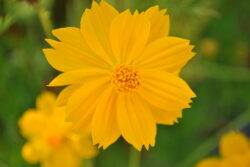In this article, we will discuss how to grow Cosmos in containers. If you are looking for a container plant that is laden with blooms throughout summer and well into autumn before the frosts will kill it, then Cosmos is for you.

It is in general easy to grow from seed and if you do so, you will be rewarded with plenty of blooms in no time. It is one of the lowest demanding plants in the summer display scheme and will reward you will plenty of blooms provided you are prepared to deadhead regularly. They also make excellent cutting flowers and are so well worth the effort.
The most likely species of Cosmos you will find is Cosmos bipinnatus and Cosmos sulphreus. In fact, it is best to use a mix of different varieties of different colours and different heights, as this will be cheaper and will give the most impact.
HOW TO GROW COSMOS IN CONTAINERS
It is best to grow Cosmos from seed as they are plenty of varieties available and they are easy to grow. You can start to grow Cosmos indoors in March –April or you can directly sow outdoors in mid-May. Once frosts have passed in late May or June, then you can safely plant indoor grown plants outdoor once it is safe to do so.
STARTING FROM SEEDS
If you are growing Cosmos in a greenhouse or in homes, you should start seeds in March and April. It is easy, all you need to do is fill a seed tray with good quality seeds compost and water well until the compost is moist. On top of the compost, lightly sprinkle the seeds which should be easy as the seeds are large and thin. Space them at equal distance and them cover with a 1cm layer of sieved seed compost. Cover with a propagator lid and then place it either on a greenhouse shelf or on a windowsill. After a few days, the seeds will have sprouted.

Allow the seedlings to grow on and eventually, they will be large enough to handle, where you can prick them out and transplant them to individual 10cm pots full of multipurpose compost. Once three true leaves appear, you can pinch the growing tips as this will encourage it to branch out. The plants then can be allowed to grow on and be hardened off in Mid-May to be planted outside in containers.
If you are direct sowing the seeds, you will need to place the seeds 8cm apart. About three weeks later, the seedlings should have popped up and once 3 true leaves emerge, you can pinch out the growing tip to encourage the plant to bush out and flower more freely.
GROWING IN CONTAINERS
At this stage, you can plant hardened off home-reared plants and shop-bought, garden-ready plants in exactly the same way.
All you need to do is select an appropriate sized pot with plenty of drainage holes and fill it with any multipurpose compost. It does not even need to be of good quality. Dig a hole slightly bigger than the root ball it came in the original container. Place the plant in the hole so that the top of the root ball is at the same level as the top surface of the compost. Backfill with the growing media, ensuring that any gaps are filled with more compost. Firm it in and water well.
As the plant grows it will need to be supported, so leave some room so that the plant can be staked. For pots, it is best to use dwarf varieties as they will be in dimensions with the container itself.
You will need to water Cosmos regularly, especially in drought conditions. Once the top surface feels dry to the touch, it is time to water. You will need to feed Cosmos in containers, every 2 weeks whilst in active growth with a high–potash liquid fertiliser to help to produce its flowers.
PLANTS WILL NEED TO BE STAKED
The taller varieties as said earlier will need to be stalked and the easiest way to do this is to use a Bamboo cane and tie it in with string at 15cm intervals. You will need to tie in every single one of the stems or in windy conditions they will break.

Another way to support the plant is by the use of pea netting. You simple stretch the net over young plants supported between bamboo canes, where the fern-like leaves of the plant will soon cover the netting, so it will not be visible.
You will need to remove spent Cosmos flowers and if you do this, they will flower continually from summer to first frosts. To deadhead Cosmos, follow the stem down to where the dead flower meets the leaf joint. In this way, you will promote flower bud production.
Cosmos Atrosanguineus (Chocolate Cosmos) is an exception as it is a tender perennial. In winter, they can be brought inside the cover of a greenhouse and next year you will get new growth and new flowers.
PESTS AND DISEASES
Earwigs can eat the flowers, but as they keep fruit flies to a minimum, then it is best to tolerate them rather than using chemical control.
Slug and snails will attack young pots, so use pellets, wool deterrent matting or traps to protect them. Older plants are not attacked. Occasionally cosmos will mot flower, which is caused by planting in too rich or by feeding with a high nitrogen-rich fertilizer.
A fungal disease that the plant can suffer from is powdery mildew, a fungal disease in which a powdery white coating develops on the leaves. The best way is to avoid it in the first plant by ensuring there are enough gaps between the plants, and that air can circulate between plants.
Make sure that the plant is watered regularly but not too much that the Cosmos is waterlogged.
Fusarium wilt can be a problem that causes the stems and leaves to die and the growth to be stunted. If noticed there is nothing that can be done and you will need to pull the plant out and dispose of it in the bin. Do not compost the affected plant.
Some of the newer varieties will suffer from rust if they are planted too late. It is better to plant on March indoors so that the plant has a well-developed root system that will protect the plant. Always make sure there are gaps between the plants and that air can circulate around the plants.
VARIETIES TO GROW
Cosmos bipinnatus is the most common species to grow:

The best to grow includes ‘Purity’ that has pure white flowers, ‘Frizzy’ has frilly, pure white flowers, ‘Xanthos’ has off-white, yellowish flowers, whilst ‘Seashells Mixed’ and ‘Sensation Mixed’ has white, pink and dark pink flowers. ‘Dwarf Sensation White’ is a compact variety with pure white flowers.
‘Rubenza’ and ‘Dazzler’ have dark red flowers, whilst ‘Double Click Cranberries’ has semi-double, cranberry coloured flowers. ‘Double Click Rose Bambi’ has beautiful, semi-double, light pink flowers and ‘Velouette’ has an even darker red coloured, single flowers.
‘Candy Stripe’ has pink and white flowers, whilst ‘Senate Carmine’ has carmine coloured flowers. ‘Sensation Pink’ has pure pink flowers.
Cosmos sulphureus ‘Bright Light’ and ‘Polidor’ has vivid, orange and yellow flowers, whilst ‘Tango’ has even deeper orange coloured blooms.
CONCLUSIONS
In this article, we have discussed how to grow Cosmos in containers. It is such an easy plant, very easy to grow from seed. All they need is water when dry, fertilizing every 2 weeks and deadheading to keep the plant productive. They are in colour for many months and so it is recommended that you grow some in containers to give a colourful summer display. You have so many varieties that can be grown with a few being selected in this article.
If you have any comments or questions that you wish to make on growing Cosmos in containers, please do so in the comment box below.
Happy Cosmos growing.
